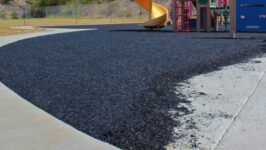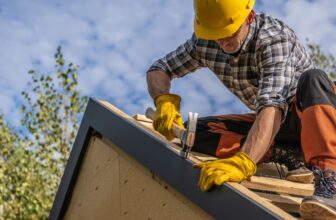
Why Rubber is Better than Epoxy for Poured-in-Place Flooring?

Sometimes in life (especially during the construction of a new house or carrying out complex repair work), the time of choice comes; you must make a clear choice about the materials that will be a solid basis for the poured floor because of durability, high quality, and an attractive price are important to you. You are looking at epoxy resin for poured floors – this material is brilliant; poured floors made of this material can be created to your taste with an individual design solution that will be an aesthetic addition to your home. On the other hand, there is another option, which is a rubber surface for a poured floor. This material is the most durable and easy to install; such bulk rubber floors are cost-effective and incredibly versatile. To help you decide which of these two poured floor materials is right for you, let’s take a closer look at the key ins and outs of epoxy resin and rubber poured floor materials, including their undeniable advantages and significant disadvantages, as well as their active use cases.
Rubber’s Resilience in High-Traffic Areas
A poured floor made of rubber materials is a floor that is extremely stable in high-traffic areas because such a poured floor is made, as the name suggests, from rubber. The source of the rubber material for the poured floor is rubber, which is used in many industries because it is extremely strong and inexpensive. Rubber can be completely different – it can be natural rubber made from latex, synthetic rubber from byproducts, or rubber from recycled products such as car tires. The bulk floor made of rubber materials is actively used in various areas with intense traffic; it can be various playgrounds and surfaces on which a large number of people pass daily. A rubber-poured floor, the basis of which is rubber, is resistant to mechanical damage, different temperature conditions of operation, and contact with sunlight; it does not deform over time and does not need to be maintained. As mentioned above, precisely because of their strength and ease of care, rubber-poured floors find their active use in many areas, such as school playgrounds, sports halls, and even large commercial enterprises.
Rubber’s Non-Slip Advantage Over Epoxy Surfaces
Rubber flooring materials are available on the market in many forms: these types of surfaces are great for extra grip and protection in high-traffic areas. Epoxy surfaces are much more slippery, unlike bulk floors, which are based on rubber. You can find out more about rubber-poured floors on the SafeStep website by following this link: https://safestep.pro/. The bulk floor made of rubber materials has joined edges, which facilitates their installation and dismantling. It is non-slippery, so it is best suited for high-traffic areas such as home gyms. Rubber bulk floor is also produced in the form of crumbs, to which glue is added to obtain “wet rubber.” This mixture is then poured onto the target surface, and pressure is applied to set it. The rubber floor is easily formed.
Simplifying the Poured-In-Place Process with Rubber

The process of pouring and installing a rubber-based floor is quite simple and intuitive. Rubber is a practical and quite universal material; it is actively used in various spheres of life. There are some limitations in its application. Do not use this type of coating for arranging a barbecue area, a fireplace area, or any area of increased fire danger. In such places, preference should be given to ceramic tiles or cobblestones. It is not necessary to lay a rubber floor on an unprepared surface. Laying a rubber surface has its key features, which it is important to know thoroughly before starting installation work. When performing a complex installation of a floor made of rubber crumb, it is important to consider the following key points: The bulk floor, the basis of which is rubber, should be laid on the most leveled and compacted base. The optimal weather for installation is dry, without precipitation. A few days of dry weather after the installation process will significantly contribute to the most reliable adhesion, which in turn will ensure a higher density of laying. The bulk floor made of rubber tolerates different temperature regimes and fluctuations and withstands high humidity. The specific properties of the material will prevent rodents from spoiling the coating. You must understand the technology of laying rubber coating on various surfaces and the care system, which is simple and does not require significant effort or knowledge.
Rubber’s Sustainable Edge Over Epoxy
If you are planning to redo the poured floor shortly and cannot choose between an epoxy-poured floor or a rubber-poured floor, you should know that the second option is extremely resistant to different temperature regimes and different operating conditions. Epoxy bulk floors are:
- Dear;
- Design options are quite limited;
- This coating is not capable of difficult operating conditions.
Modern rubber-poured flooring offers those key qualities that can make it the best option for your space. Rubber overfill offers a cost-effective balance of durability, comfort, and versatility. Such a poured floor will provide you with a comfortable and warm surface. Rubber flooring is the only material that can provide you with the level of comfort and durability you need. Thanks to technological advancements, different colors are now also widely available for customers who don’t want to sacrifice aesthetics for functionality. Another advantage of choosing rubber over epoxy is that it can be easily removed and replaced as needed! Installation is simple and requires specific knowledge. Rubber coating can be installed directly on concrete; this material does not require the use of glue or a long drying time. Installation simply consists of connecting the tiles using the appropriate mechanisms. When the rubber tile is damaged and needs to be replaced, it can be easily removed and replaced with a new tile. This is not the case with other bulk floor coverings, such as epoxy-based flooring, which require a long time to install, regular maintenance, and expensive repairs.
The Economic Advantages of Rubber Over Epoxy
As well as being easy to install, durable, and comfortable, rubber flooring is also very cost-effective, making it the best option for high-traffic areas when you’re looking for the most bang for your buck. Rubber bulk floors are available at favorable prices. The economic advantages of rubber over epoxy are significant. Molded rubber surfaces are a cost-effective option for building or renovating high-traffic areas. This innovative material is a significantly safer, more versatile, and, in many cases, more economical coating solution than epoxy, with exciting design potential and strong environmental performance. Bulk rubber surfaces have a wide selection of colors that can create bright spaces. Use different colors to mark separate areas of the room or combine them to create a striking design effect.

The rubber infill surface uses recycled rubber, which is much cheaper than epoxy surfaces as it is very easy to install; you will also save on installation fees. The rubber easily adheres to an uneven surface, providing an even and safe area. Molded rubber surfaces require virtually no maintenance throughout the year, lasting much longer than other materials such as epoxy resin. Constant movement reduces the cushioning properties of the surface. Rubber surfaces never seal or shift over time and are extremely easy to clean when needed. The bulk rubber surface dries quickly and is resistant to various weather conditions of operation, unlike the floor, the basis of which is epoxy resin.
Making the Right Choice for Poured-In-Place Flooring
It is important to make the right choice for the poured floor. Rubber is elastic and does not deform under the influence of various factors. Molded rubber coverings are ideal for use in high-traffic areas. Rubber is made from natural materials without the use of chemicals. Rubber does not contain wood, metal, and chemicals that can cause negative reactions. Rubber bulk coating is very relevant today. The building materials market does not stand still and is rapidly developing along with technical progress. Recently, the number of floors has been very limited, especially in open areas. This includes playgrounds, footpaths, sports facilities, high-traffic areas, etc. Now is the time for innovative and modern materials. The rubber-poured floor is a completely new type of floor covering, which is used to create safe outdoor and indoor spaces. Such a poured floor is made of a simple but durable material – rubber with additional elements. The rubber-poured floor is characterized by a long service life, wear resistance, affordable cost, and various design solutions.



















































































